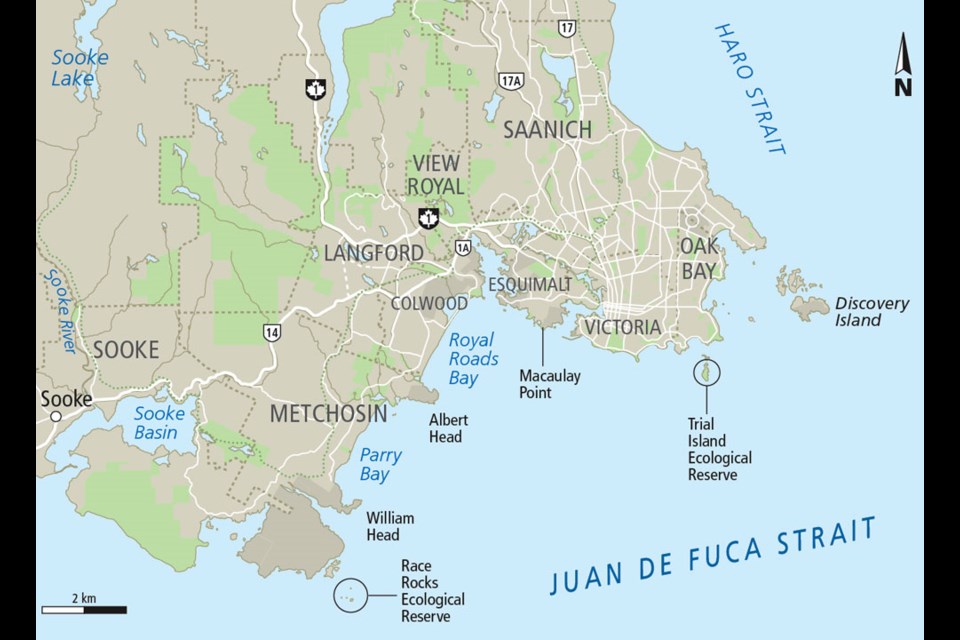I’ve spent more than 35 years fishing and diving for a living in the receiving waters of the Capital Regional District’s untreated sewage discharges, and have witnessed their degrading effects.
Saxe Point, for example, was a vibrant and diverse marine environment in 1977, the first time I dove there. Like many other places around Victoria, it is a highly degraded shadow of its former self, changes I attribute to the CRD’s sewage discharges.
The sewage discharges appear on the local seabed, reefs and even the marine life itself in the form of a fine, greyish brown sediment with a grotesque “adhesive” quality. Visible accumulations appear about 50 feet of depth and intensify the deeper you go. Vast areas of the local seabed are contaminated, particularly where the conditions are favourable for the accumulation of sediments.
An example is illustrated in my diving video entitled: “CRD sewage outfall pollution in Victoria BC” posted on YouTube.
This impact can be understood by examining how the tidal currents circulate within the confined waters of the Victoria Bight, which is described in The Current Atlas for Juan de Fuca Strait, published by the Canadian Hydrographic Service.
During the ebb phase of the tide, the current flows very weakly, often less than one knot, over both outfalls. The sewage discharges trundle west toward Royal Bay, Albert Head and Parry Bay in Metchosin. The land mass of Colwood and Metchosin deflects the ebb current southward toward William Head and Race Rocks. Before the discharges can travel as far as Race Rocks, the tide changes, the current reverses and then ingresses heading north — straight back toward Victoria.
The seabed between the Macaulay Point outfall, west Constance Bank, east Race Rocks, and William and Albert heads is a prime sediment-deposition area and a septic mess. Recent CRD sampling of the seabed sediments, collected on a transect from the Macaulay Point outfall travelling south about halfway to Race Rocks, revealed levels of seabed fecal coliform contamination in this area ranging between 5,000 and 13,000 fecal coliforms per 100 millilitres. The public health standard for swimming is about 200 fc/100ml.
On the flood tides, the discharges are pushed east toward Trial Island, then northeast through and around the Oak Bay islands and into southwestern Haro Strait, exposing the entire seabed throughout this area. The Oak Bay Flats, between Trial and Discovery islands, and the seabed between Ten Mile Point and Gordon Head are prime sediment-deposition areas.
About the time the effluent travels into the lower part of Haro Strait on the flood current, the tide turns, the current reverses and the ebb current pushes right back through Oak Bay toward Victoria.
In my experience, the visible footprint of the CRD’s outfalls extends from slightly west of Race Rocks at the entrance of Juan de Fuca Strait and goes all the way around to the Gordon Head area in southwestern Haro Strait.
It’s sadly ironic that Trial Island, the Chain Islands in Oak Bay, parts of Discovery Island, Ten Mile Point and Race Rocks are ecological reserves supposedly for the benefit of conservation, yet their submarine environments are exposed to the CRD’s chemical- and microbe-laden sewage discharges.
A sanitary closure restricts the harvest of shellfish over a vast area of the local seabed. To ensure public safety, the recreational harvest of deep-dwelling swimming scallops is prohibited in all of Area 19, which stretches from Race Rocks to Sidney. The local swimming scallops are filter-feeding on the sewage discharges and are unsafe for human consumption.
Modern sewage-waste streams contain many harmful pollutants and toxic chemicals, most of which are entrained within the solids and sludge that would be removed during the sewage-treatment process.
These include pharmaceuticals and other persistent chemical compounds such as flame retardants and microplastics. Much of the microplastic is derived from petroleum-based textile fibres from laundry discharge.
Untreated sewage also contains huge loads of viral and bacterial pathogens, some of which can survive for long periods of time in the marine environment.
Recent studies in Washington state have confirmed that our southern resident killer whales have been exposed to more than 25 human-sourced pathogens and might well be the most chemically contaminated population of whales known to science.
For those interested in reviewing some quality science regarding bio-accumulation and food-web contamination in our local marine environment, watch “Protecting B.C.’s Marine Mammals from Land Based Pollution” posted on YouTube by the Vancouver Aquarium.
I’d like to see that vibrant and productive marine environment return again in my lifetime. Sewage treatment is long overdue.
Allan Crow lives in East Sooke. From 1978 until 2013, he dove year-round in local waters harvesting octopus and collecting specimens for local aquariums, including Undersea Gardens, Sealand and the Shaw Ocean Discovery Centre.



